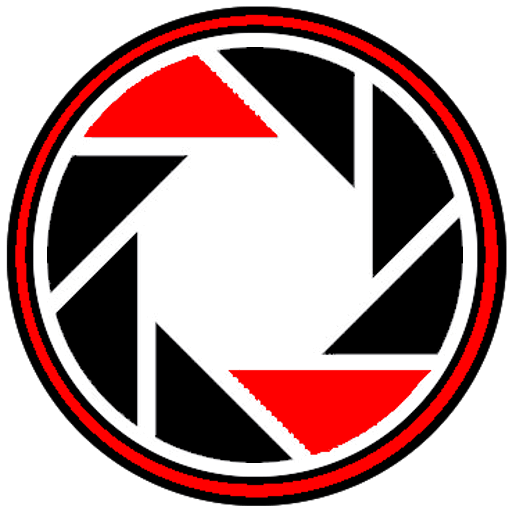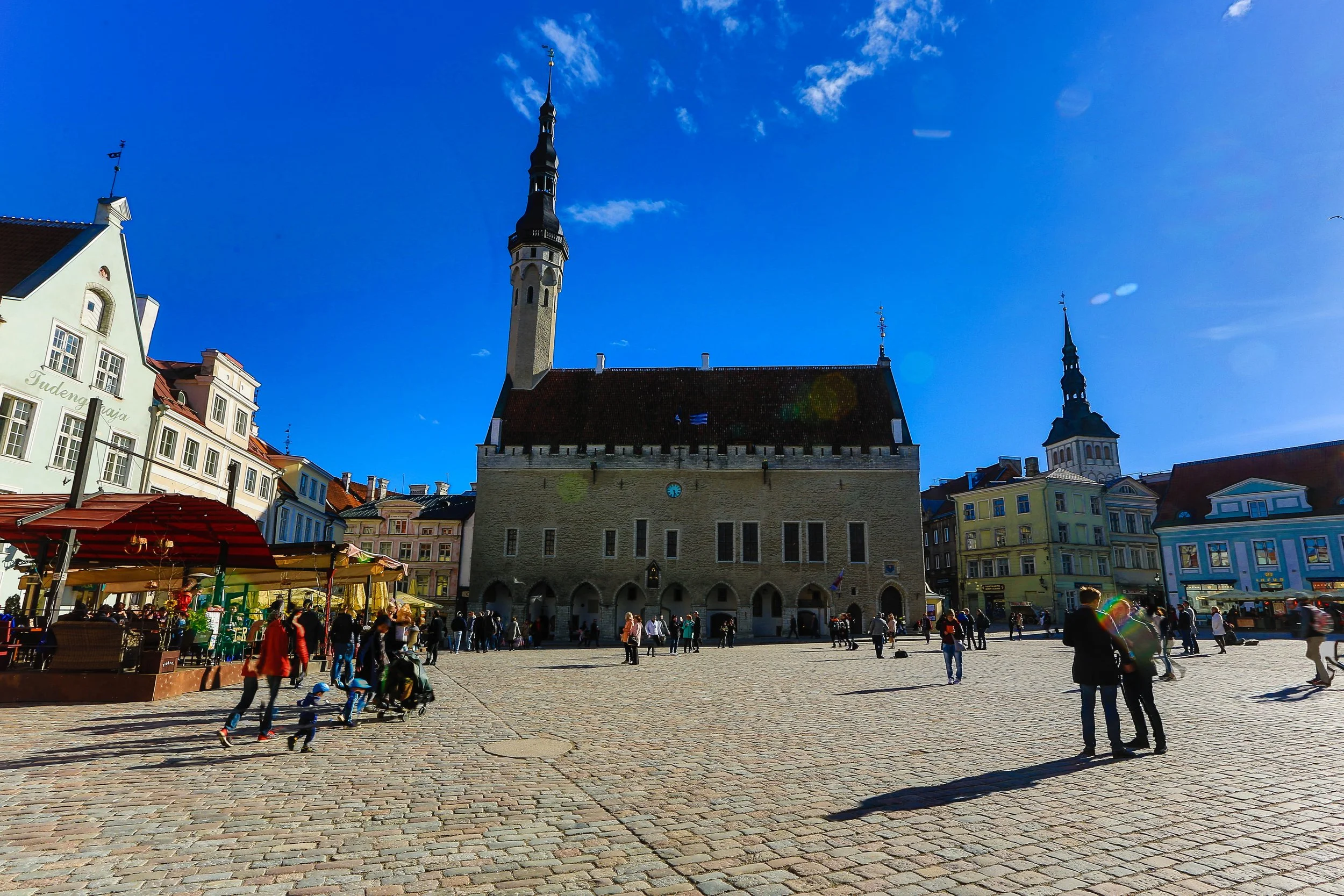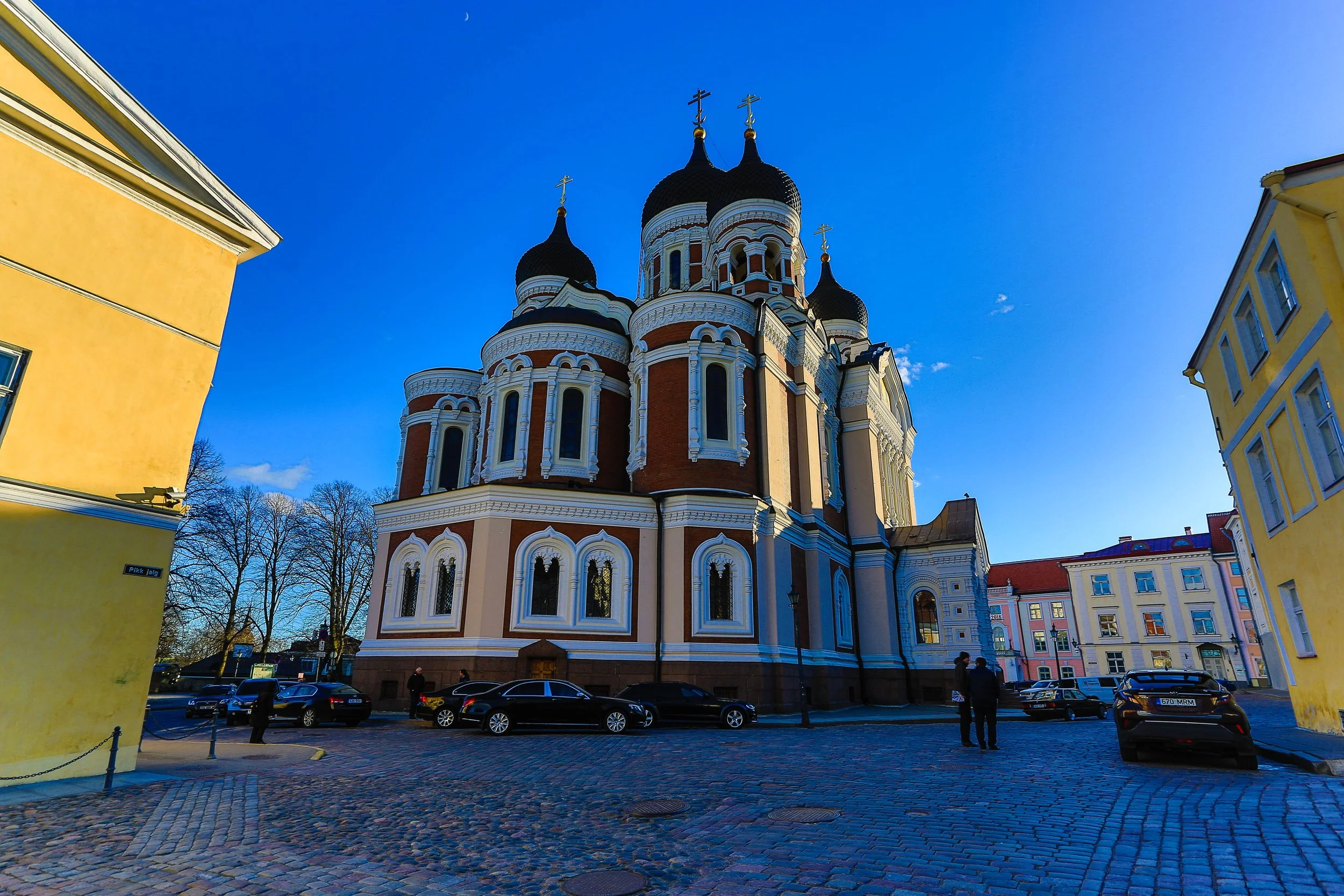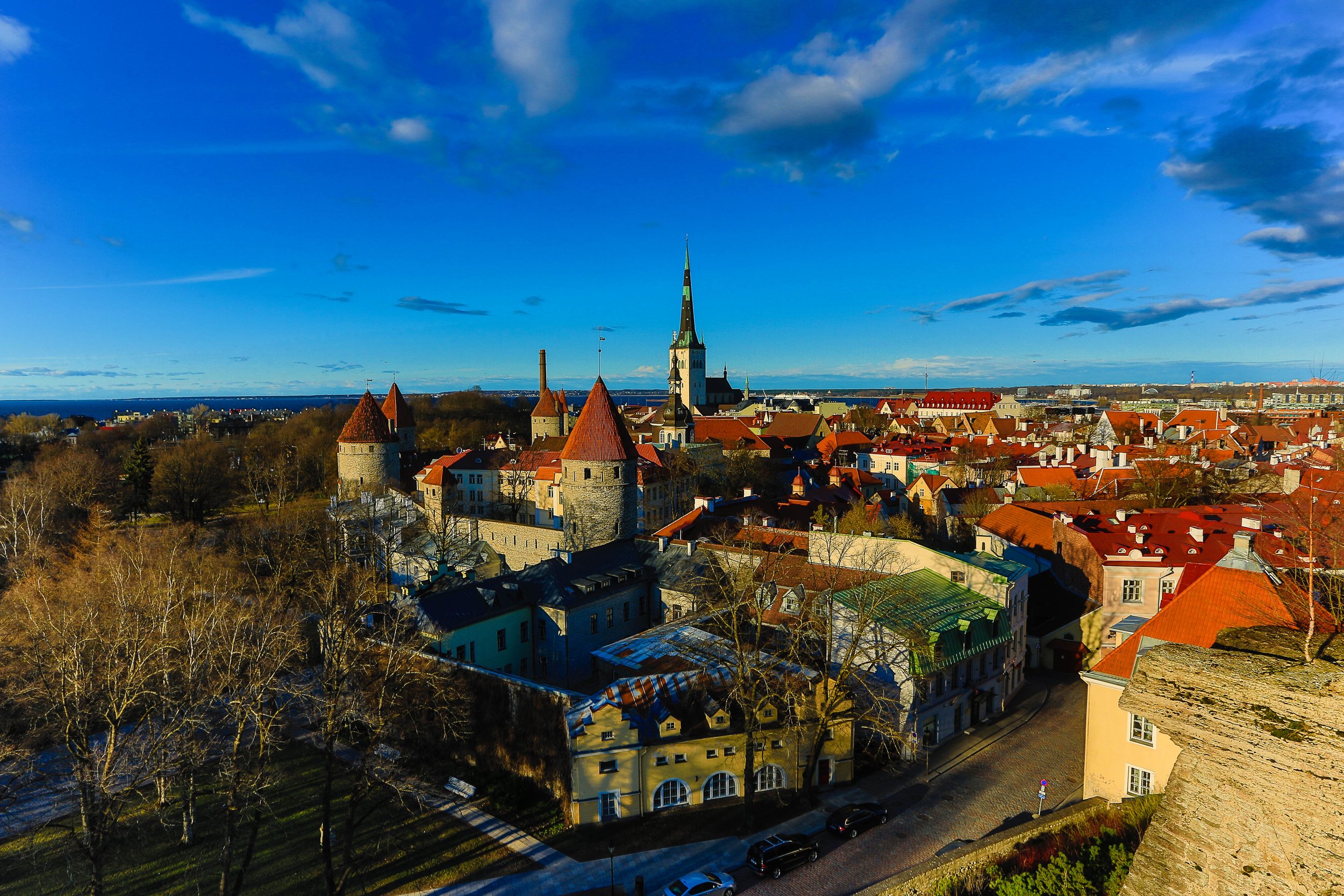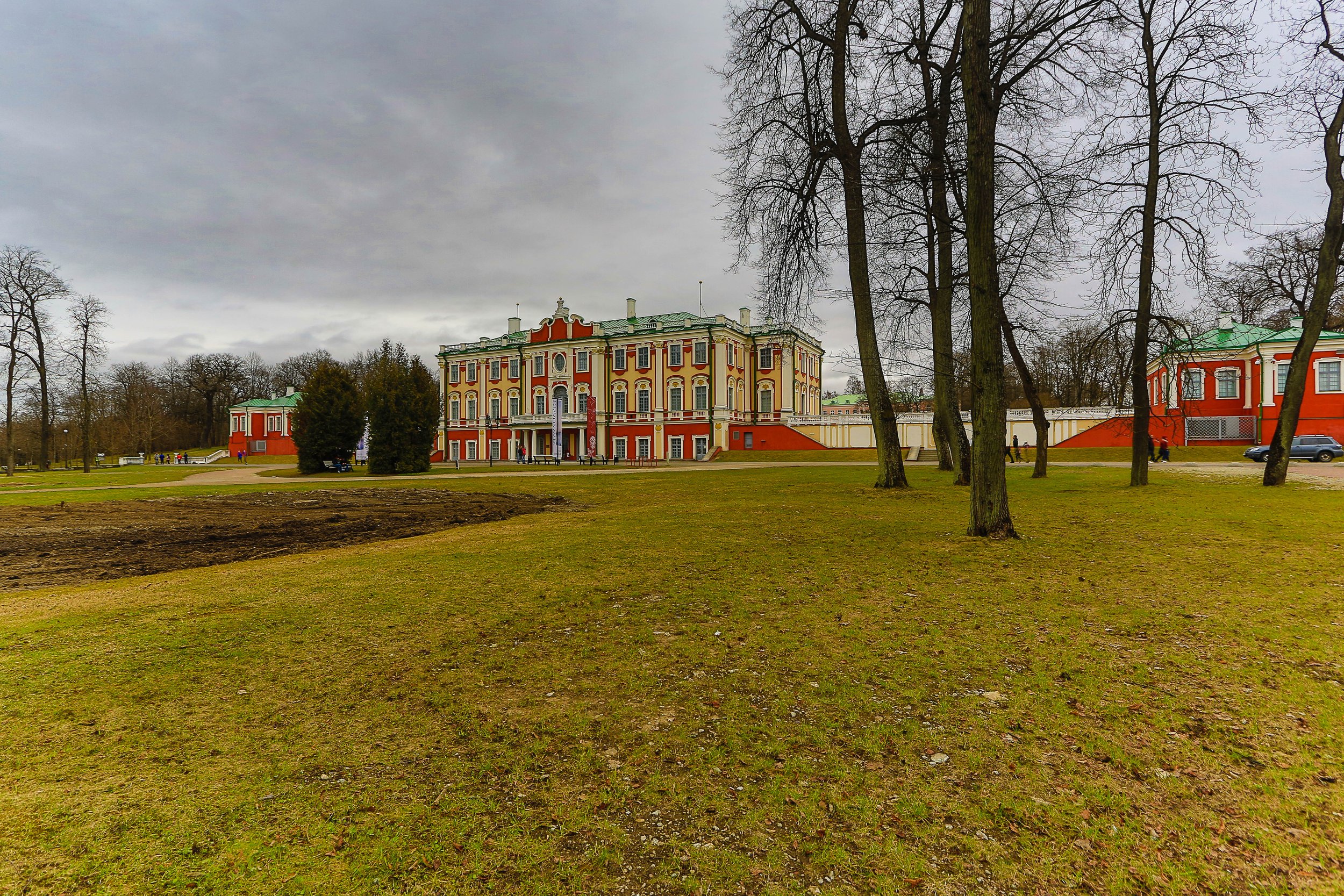Talinn
“Quaint” it is both quite small and very old, storybook streets of cobblestones and brightly painted houses. Tall towers of stone topped with red tiles.
The old town is a lot like the outdoor museum in Oslo, a place of history. Toompea is this even more distilled.
The public transport is excellent, cheap easy to navigate and pretty modern. The fact there are direct trams to the airport is very helpful.
As you move outside the old town the Russian and Soviet influences becomes more clear. Tsar-ish palaces and brutal soviet concrete war with bright signs of commerce and glass fronted stores of high fashion.
Day 1:
I typically prefer to fly out the night before rather than taking a flight first thing in the morning, but there was not a practical solution for this with my trip to Talinn. Direct flights were also problematically timed, so I ended up getting up at 5:45am for an 8:30 flight to Helsinki before taking a tiny plane to Talinn. 30 minutes in the air, for some of which I was sat in a seat facing the rear of the plane!
Coming in over the city, the only impression I had was “brown” through sprint has started the eastern European plants don’t yet believe it.
The airport is a decent size considering how small Talinn is. There is a tram directly outside making it a breeze for me to get to the Freedom Plaza where my hotel was. Before checking in, I stopped at a German Beer Cellar for dark beer, dark bread, sausages and sauerkraut, covered in mustard, really good, heavy food. I then dropped my gear at the hotel, staying on the 7th floor with a skylight rather than windows and headed into old town.
Directly opposite my hotel is the Jaani Kirk, a yellow church from the mid-19th century, almost net door is Vebadase Väljack, the freedom square, dominated by a huge cross and an underground shopping center.
I tried going to the nearby Carved Stone museum, but it was closed despite its claims on Google and the front door. Instead I went to the Kiek in the Kök, “Peek in the kitchen” tower and museum.
Talinn is unusual in that much of its ancient city walls and towers are still in place and this tower is one of the largest in the wall. Five floors cover historic photos, weapons, devices and experts on each floor talking you through the exhibits. The top floor has a cafe (closed) with photos exhibit and a huge spherical stone clock.
The name comes from the hole in each floor allowing weapons and ammunition to easily be holstered up the tower. It is not a huge museum, but has a lot to keep your attention. It also has some great views over the city.
After the tower, I walked into the old town centre, past anther church. The main square itself has a dutch vibe. wide, open, surrounded by faces and restaurants. One side is the town all, with Old Tom the weather vein on its roof. I stopped here for a beer, which they heard as “Bear” and were still able to offer from their menu…
I walked over to the nearby photography museum, set in the old refurbished jail. Again, not a very big museum it has a permanent exhibit of early photography, including one ‘actual size’ coloured by hand.
The top floor has a collection of equipment and a short view narrated by a young American camera enthusiast and at the time of my visit a series of WWII era photographs of pilots and their planes.
The basement floor was perhaps the most interesting. 15 students from the local university, their work as they learned and their graduation pieces. Some missed the mark, but as a collection it was great to see. They were also framed with coloured tape, which is an innovative approach.
I intended to then go to a different museum, the museum of stories, but walking past it, it was so fundamentally tacky, with people outside in costumes it made Madam Tausaudes seem tame, I avoided it and stopped instead at a cafe off Freedom Square to watch people go by.
My evening was pretty relaxed, I had dinner at the hotel as it was highly recommended, (though comparatively expensive) and enjoyed a fantastic pumpkin soup with delicious teak as a main. I then went to the sauna, steam room, pool and jacuzzi, all of which were deserted so I amused myself singing show-tunes into the domed ceiling of the pool. Badly.
Day 2:
I’d been out partying quite a bit in the week leading up to the trip, generally getting home at about 3am from a club or a bar and it finally caught up with me. I didn’t get out of the hotel until 10:45 and went straight to a nearby cafe for my normal breakfast of a latte and a croissant.
Almost next door was my target, the music and theatre musuem. Turned out, I was the only one there at that time, which is a strange feeling. As there was no one else to watch, the lady looking after the place gave me a tour, talked me through the museum and its pieces and even offered to let me play the concert piano (one of only 5,000 made in Talinn). I politely declined this last offer as my musical skill is only slightly more sophisticated than Coldplay. Put another way, a monkey with a hammer can play a tune better than I.
Whilst a small museum, it is well laid out and showcases six ‘stories’ which highlight a part of Estonia’s rich musical and theatrical heritage. It is a little similar to the 9 bites in the city museum of Helsinki in concept.
In the tower, part of the city walls and the jail, (a climb up which highlights how much smaller people were in the 13th century) was small exhibit on Natural Dance.
I then went over the road to the St. Nicholas Church and Art Museum. An old (though rebuilt) church with a collection of ecclesiastical art work, the most famous being the Danse Macabre, which is an impressive work, taking up the full width of one room, though not as well lit as you would like, the glass protecting it gives off terrible reflections. They were also showcasing the “Forgotten Five”, five paintings from the archive that had not seen the light of day in a century. Whist not particularly fine work, the mindset of brining out different pieces was very appealing.
By this point it was lunchtime, and so I walked the cobbled streets of old town and found a place called the Golden Pig, by all accounts a traditional Estonian restaurant, or at least an Estonian Restaurant offering tourists a taste of their history. The waitresses were in traditional garb, the walls were whitewashed and the wood beams and tables all a pale wood.
It was empty. I was the only customer, which is always a somewhat awkward situation to be in. The food was great, an elk stew with roasted vegetables, wild mushrooms and mashed potatoes. Fresh baked break rounded it out and by the time I was done, the place had filled up a bit. People can be strange like that, unwilling to enter an empty restaurant, but put even one person in the window and people start coming in.
I then took a somewhat rambling walk to the Talinn City Museum, passing a small church with a famous clock and another of the city’s towers.
The City Museum is split over five small floors. The basement has ceramics, copper and tin from Talinns past, the ground floor has a small but detailed temporary exhibit on firearms and the top three floors take you though the cities history from its dominance by medieval guilds to its recent independence form the Soviets. The story of the “Singing Revolution”, 300,000 Estonians singing a song for independence during the national song festival, under soviet rule is inspiring as is the 600km Baltic Human Chain through Estonia, Latvia and Lithuania.
I then took a break from history for a quick beer at a dive bar nearby, having had enough of fancy places and tourist traps.
I did pass the Museum of Russia, but it is tucked away, the signs are subtle as it if is in poor taste to make too much of itself.
My final museum of the day was the Estonia History Museum, set in the Grand Guild Hall. Only two floors, it highlights the strong quiet pride the Estonians have in their country. Touch screens ask you questions on the materials around you and displays of artefacts are scattered around the rooms in glass cases shaped like talons.
The basement is more a history of the guild as well as a display of weapons. There was also an exhibit on Martin Author and the reformation. Cheerfully asking “Which Religion was right?” For such a secular state, it is a peculiar question.
Done with museums for the day I stopped in the Beer house for, shockingly, a beer. When I asked for a large beer, the bartender picked up a stein but I managed to stop him before he started filling it!
I tried the double dark larger which was great, with malted caramel tones and the Honey Ale, which was a bit sweet for my taste.
Finished with the bar, I walked up the steep hill through the Leg Gate to Toompea, the oldest part of old town, and the raised hill-fort. Several churches (Including a very Russian Orthodox one, which was surrounded by expensive german cars when I arrived), a lot of souvenir shops and a couple of bars are all the commercialisation of this area. Otherwise it is expensive houses. There area couple of viewpoints scattered around giving various views of the city. The change in perspective did make me realise how focused I had been on old town, skyscrapers I had not seen dotted the landscape.
I took a different route down, past some statues of monks, bigger than life.
The first place I tried to go for dinner was totally booked, not a surprise, as it was Talinns most recommended restaurant. Instead, I followed my gut and went to an Italian in a cellar. The starter of Wild Mushroom polenta was fantastic, the main of game ragu tagliatelle was great and the Tiramisu was peculiar, topped with something a bit like cooc-pops.
The walks back gave me a couple of grand views in the moonlight before I went to bed.
Day 3:
I was up, packed and at the hotel breakfast my 10:5. I spent some time trying to figure out what I would do in the morning I knew after lunch I wanted to go to KUMU, the art museum, somewhat out of town, but the nearby occupation museum had mixed reviews, most saying it was just a series of 30 minute videos to watch.
My investigations revealed there were actually several art museums at the suburban park near to KUMU and so i decided to go to Kadriogen, the most famous first.
It was an easy tram ride to the park and then a short walk through the pleasant greenery to reach Kadriogen Art Museum. Holding classic works and a good collection of Faberge silverware.
The museum is surprisingly small given the size of the building, but it also had a reception hall used for performances and one was going on as I was there, some school children performing with Zither and Cello music. What we might with some unfair snobbery call folk-music. It is important, vital even to Estonia’s sense of self. These performances meant I was unable to pass through to some of the rooms, which would perhaps have increased the size of the museum.
Leaving the museum, I passed the office of the President, comparatively modest compared to the Tsarist plunder of Kadriogen or the ultra modern KUMU.
Inside and out, KUMU and the Helsinki Contemporary Art museum share a lot of similarities. A curved ramp from the entrance, a semi-circular shape. It was a strange experience.
There are essentially four floors, permanent collections on the main wings of two of them, and temporary exhibits in the grand hall, the winds and the top floor.
Perhaps my biggest take away is how parochial my knowledge of art is. I know Matisse, Picasso, Rembrandt and other more niche artists, but here focus is given to baltic and Russian artists who’s background and style were largely unfamiliar.
One temporary exhibit, #historyinimages tries to capture Estonian realms of memory and focuses on history and myths completely outside of my experience. It is both humbling and why I travel.
One of the permanent exhibits relates to the soviet area as it must, mixing soviet realism with subversive ‘unofficial’ works. On one wall, a series of jokes are shown from the occupation. My favourite was “Why did the soviet troops cross into Czechoslovakia?” “Why” “Because there are no borders between Soviet countries”
The top floor was a strange exhibit called “if you could only see what I’ve seen with your eyes” a line from Blade Runner, looking at species extinction and the changes to the earth. Using plexiglass mobiles with facts on them, and semi organic seeming sculptures you got a strange experience, and one once again a little reminiscent of the top floor of the sister museum in Helsinki.
The Grand Hall had a collection by Leonhard Lapin, called void and space. A founder of Estonian Pop Art. His work was multi-material and vibrant, but not particularly captivating for me.
A strange museum, with a wide collection, I left feeling vague unsatisfied, but as I write these words I realise it is one of the more profound emotional responses I have had to art at a museum.
Museums done for the trip it was time for lunch before flying. I had passed a Mexican with excellent reviews and so headed over and was told by the long-haired moustachioed owner in an overworked voice to leave as they were full.
I took a tram back towards the centre and stopped for some fast Italian food at a Vaipana, a nordic chain, chaotic in its approach. You are given a NFC card when you arrive and you oder food at different windows depending on your taste and drinks at the bar. You collect it when the buzzer goes off and pay using the card as your ‘order’ at the exit point. Strange and inefficient.
The airport is incredibly easy to get to, a 20 minute tram ride from the centre and you are dropped right by the main terminal. five minutes walk at most. I arrived at 15:31 and was through Customs, next to my gate and had beer in hand by 15:40.
In a lot of ways, this was my favourite city, it was distinct in a way the others have not been. Rome, Oslo, Düsseldorf, are all deeply “European” in their history, defined by the actions of the big players in European history. Estonia is heavily influenced by Russia, but also by its own lack of importance. It was ignored on the world sage for centuries, only important as someone else province, and yet it has a history, language and mythology that is rich and survives to this day, despite the curses in the 12th century, the Germans, Russians, Swedes, Danes and Soviets ruling them. How few in England know the Green Man?
I was startled by the importance of music in Estonia, I have a Brits cynicism to it, too many years of manufactured music sold to anyone biting and our own “Folk Music” is seen as a laughable thing to mock, little England with its bells and sticks around a may poll before tea, Estonia took their folk music and sang, over 300,000 of them against oppression and soldiers. The only thing I have ever experienced that even comes close to this bravery was seeing Femi Kuti perform in Lagos, but I fear I never really appreciated as I should.
A bloodless revolution, lead by hundreds of thousands of people raising voices not weapons. Raising them in harmony not hatred. Estonia deserves more recognition than it ever gets.
